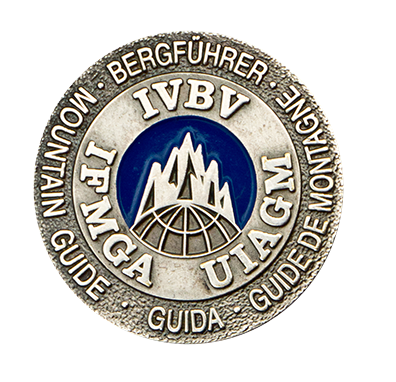Managing uncertainty in avalanche terrain.
Close Calls with Avalanches
“A close call is a free lesson. ”
The fastest way to learn about avalanches is to almost get nailed by one. Not killed or hurt, just really scared. Where you can brush off the dust, thank Ullr, and analyze the shit out of what happened.
Psychologists say we learn best from instant feedback. An example of instant feedback is pulling on a small handhold while climbing. If we don’t fall off, we get instant feedback that we made the right decision. They also say—notably Malcolm Gladwell in his book Outliers—that we need 10,000 hours in an instant feedback environment to become an expert. That means you can become an expert sport climber after 10 years of clipping a lot of bolts.
Not so easy with avalanches.
The problem with avalanches is they rarely provide instant feedback to the backcountry skier. If we ski a 35-degree powder slope during considerable danger, and it doesn’t avalanche, we get feedback that we made the right decision. But what if we skied within a meter of a trigger spot, that would have ripped out the entire face? Then the feedback we got was wrong. And we learned wrong.
For us backcountry skiers, our best instant feedback on avalanches is when we actually start an avalanche. If you can accept that you’ve made a mistake, it’s time to debrief and learn. In the past couple years, I had three of these close encounters with avalanches. I survived, and learned.
Lesson #1: The Coffee Avalanche
In mid-April 2015 I was on my third Denali Ski Base Camp in a row. This trip was with the Eagle Ski Club to the Coffee Glacier area. It was our third day of skiing in a zone I’d also skied the week before. The weather was clear, calm and warm.

We started the day with a low angle glacier run to a steep moraine headwall. I stopped on the flat crest of the moraine and looked down to the powder field below. A client skied up to me on the flat moraine bench and said, “That looks good! Should we ski it?” I struggled with the desire for powder and a feeling the slope was not right. After all, I stood at this same place the week before and not skied the slope, but the powder looked so good….
Another client skied up and joined us on the moraine. We heard a small whoomph and the moraine wall below us fractured a meter deep. The avalanche sliced around the top of the moraine, ripping out of sight around the corner, spilling deep and heavy into the valley below. “Yeah, I guess we won’t ski that.”
After the avalanche we skied on northerly aspects, away from the runout of sun warmed slopes. The following days cooled, allowing us to ski steep chutes and powder fields with no more signs of instability.
What the Coffee Avalanche Taught Me
This was one of those situations where it’s normal, normal, normal, then boom! it’s not normal. It’s easy to become complacent when conditions remain the same for days on end. The problem occurs when there’s a subtle change in conditions, such as wind from a different direction, when we’ve let our guard down. Active backcountry skiers have all experienced those “I didn’t expect that!" moments.
So how do we stay mindful to changing conditions? One technique that Todd Guyn suggested at ISSW 2016 is to say, “What am I missing out here?” The statement promotes discussion and thought. I've seen this statement work miracles while teaching at the Alaska Avalanche School. It often gets the quiet person to speak up and the unseen is made apparent.
Another learning point from this avalanche was to watch the first warm day after a storm. What is warm? It’s when you drag your skip pole and the snow lumps around your basket instead of piling like dry sand. It’s when snow powder plops off solar aspects rather than puffing down as spindrift or dry loose avalanches.
This first warming and wetting of the snowpack from warmth—warmth from either solar or air temperature—can re-activate dormant weak layers. The wetted snow creeps and pulls downhill like a glacier, magnifying stress on weak layers below.
Lesson #2: Flattop Mountain Avalanche
In March 2015, two teenage brothers from Florida joined me for skiing around Anchorage. We first tried Turnagain Pass, but it was pouring rain. We drove back to Anchorage and tried the Chugach Front Range from the Glen Alps trailhead.
To introduce the brothers to the backcountry, we toured to the left edge of a 150-meter long wind slab to look at snow layers. The slope was about 15-meters high and tilted to 20 degrees, a full 10 degrees less than what’s normally considered avalanche terrain. I probed the pencil-hard slab with my probe, feeling a hollow layer of facets at the base, between the slab and rocks. A good place to show the brothers a weak layer.
As I dug a meter to the ground, I felt a collapse and the entire slab began to move, slowly breaking into massive blocks. One brother was off the slab. I stepped off the moving slab, only to realize the other brother was sitting on the moving blocks, laughing, like a rabbit in the car headlights. I stepped back onto the moving slab and drug him off. The massive blocks moved five meters and stopped. Riding out the moving blocks might have worked, but getting sucked under would have sucked.
What the Flattop Avalanche Taught Me
This was my big wakeup call about hard slab avalanches. They let you get out in the middle with no feedback, then they crack far uphill from you. They seem to catch more avalanche professionals than any other avalanche type.
This wind slab on Flattop seemed to have collapsed on the 20-degree slope where we stood and propagated 100 meters to where the slope steepened enough to move. The slab’s rigidity allowed it to pull out all the way back to the 20-degree slope where we stood.
Being so close to a popular trailhead, I immediately worried people would find out it was me who was involved. I worried people would question my decision making. Bystanders tend to judge the abilities of the people involved in avalanches. This phenomenon is a natural instinct known as the attribution bias, better known as Monday morning quarterbacking. This causes us to judge rather than learn from avalanche accidents. The attribution bias has another side. When an accident happens to yourself, you tend to blame the circumstances rather than considering the mistakes you made. Either way, the attribution bias prevents learning. It's like shooting yourself in the foot.
The Utah Avalanche Center has worked to shift away from a culture of blame in avalanche accidents. As former UAC director Bruce Tremper said to Sportgevity:
“At the Utah Avalanche Center, we have a strict policy to not criticize the decisions of people who tell us about their incidents. We don’t care who they are and what decisions led them to it. We just want to know about the avalanche activity and snowpack conditions because that can help to save other lives.”
As bystanders to avalanche accidents, we need to take the it-could-have-been-me approach. As someone involved in an avalanche, we need to realize we made a mistake. Whether bystander or someone involved, the objective from each avalanche should be to learn and be better prepared next time.
I met the Florida brothers the next morning for our second day of skiing. We actually nailed perfect conditions at Summit Lake. They told me they came to the conclusion that the avalanche was a rogue event. After thinking about it, I realized they were right. It was a rogue event. An outlier. They say snow is stable 95% of the time. That means avalanches are outlier events. Avoiding avalanches is about having an outlier mindset: to move a bit further out in the valley from the runout, to give the cornice a wider berth than is needed, to imagine the fracture line cracking higher than expected.
That wind slab was five days old. Wind slabs often stabilize in a day, but not when they’re over persistent weak layers like a thick layer of advanced facets—an outlier situation that I hope to recognize next time.
In a captivating youtube, Gordon Graham describes high risk/low frequency events in the fire service. He says these dangerous situations can be broken down into two groups:
High risk/low frequency events where you have time to think. The solution, Graham says, is to “Slow down. Slooow down. Sloooooooooow down.” Slowing down has become one of the points in my 2017 system for avalanche avoidance.
High risk/low frequency events where you have no time to think. The solution: Graham says, is “They can be addressed through serious training.” Train for worst case scenarios.
Lesson #3: Ski Hill Avalanche
The end of March 2016 was storms, rain and avalanches in Southcentral Alaska. A return client, one that I really cared about, came for a week in the Alaska Range. Despite a horrendous weather forecast, we flew into the Alaska Range for the experience. Pilot Paul Roderick took us to our first choice location, it was too windy to land. He took us to our second choice location, avalanches had ravaged the slopes. Eventually, we landed near the Mountain House in the Ruth Gorge, a place best for climbing, and not so good for making turns. One small slope, called Ski Hill, rises above the Mountain House.
Despite the gnarly weather, we had a blast camping and pumping 100-vertical meter runs on Ski Hill. The driving snow and raging wind made Ski Hill exciting and welcomed exercise. At the high shoulder of Ski Hill, where the slope steepens up to Mount Dickey, I probed with my ski pole and felt a hollow layer 50 centimeters down. I looked up and wondered if I was too close to the steeper slope above.
The next day, in the raging storm, we avoided avalanche terrain by climbing a rocky ridge in the raging storm. We went to bed that night with the tent banging around like a bear wanted to be let in. The morning dawned clear, calm and cold. North America’s most rugged mountains glowed white under a deep blue sky. I looked toward Ski Hill and saw a fracture line cutting across the slope above on Dickey. The debris has splattered across Ski Hill. Not down Ski Hill, but sideways across Ski Hill. I felt nauseous and went back inside the tent.
What the Ski Hill Avalanche Taught Me
I wondered why I skied so close to Dickey two days earlier. I had felt the weak layer. I knew the slope above had been loading. What was I thinking! The place where we stood had been obliterated by hundreds of tons of snow.
“Once you adopt a new view of the world (or any part of it), you immediately lose much of your ability to recall what you used to believe before your mind changed.”
This is called the Hindsight bias. The I-knew-it-all-along effect. We tend to distort the history of thinking in accordance to what we presently know. Hindsight is 20:20.
The Ski Hill avalanche was another reminder to look for outlier conditions. Ski Hill is probably safe 355 days a year. That means the outlier avalanche conditions occur 10 days a year. It’s those 10 days I need to watch out for. Like when it’s storming hard, I feel a weak layer and I’m feeling the pressure to satisfy clients. Then I need to adapt and listen to the mountains.
Summary
Use the it-could-have-been-me approach to learn from avalanche incidents.
Have an outlier mindset in avalanche terrain.
Remember that hindsight is 20:20.
To avoid complacency, ask “Is there something we missed?”
Slow down when you have time to think.
“I hope for watercooler conversations that intelligently explore the lessons that can be learned from the past while resisting the lure of hindsight and the illusion of certainty. ”
“...if the consequences would have been severe or the event caused you to change your decision-making or practices, call it a near miss.
”
Summer 2016 Rock Climbs
Cathy and I sold our packrafts and committed to vacationing on rocks. Oh, the tough decisions! This summer, between work, courses and travel, Cathy and I climbed in Alaska, California, Idaho, France, Italy, Switzerland, Slovenia, Croatia and Colorado. Here are some of the highlights.

In mid-July we went to the Elephant's Perch in Idaho's Sawtooth Mountains. It's a solid chunk of stone, with an easy walk off, placed in a range of crumbling stone. I'd been hearing about the Perch's since I was a kid—a dream come true. Our food bag hangs above our micro tent, to keep out the ballsy chiselers.
A few days earlier we shook off the Alaska moss at the City of Rocks near Boise. The City was the most beautiful place we visited all summer. Massive blocks of granite in a high western grassland. I expected to see a pioneer wagon train moving across the distant prairie.
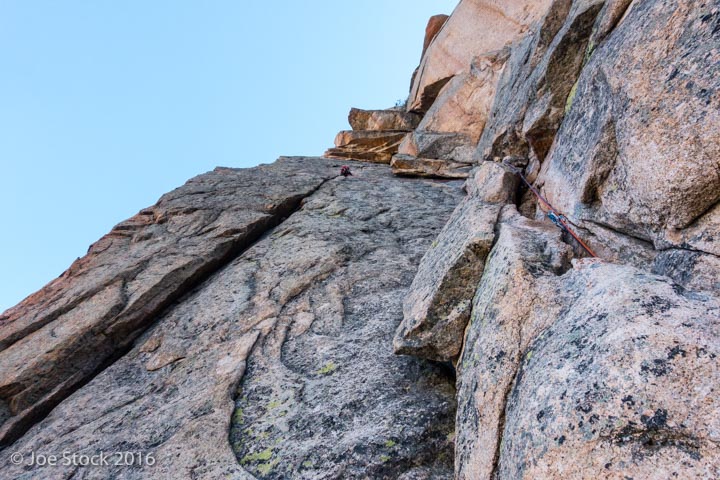
Cathy leading the first pitch of the Mountaineer's Route on Elephant's Perch. This six-pitch route is rated a soft 5.9 and is the easiest route at the Perch. All other routes at the Perch are not soft.

Cathy belaying me on pitch two of the Mountaineer's Route. The crux was near the top, described as an off-width, but was actually nice crack climbing.

After a swim, I chilled in camp with Cathy and Tom.
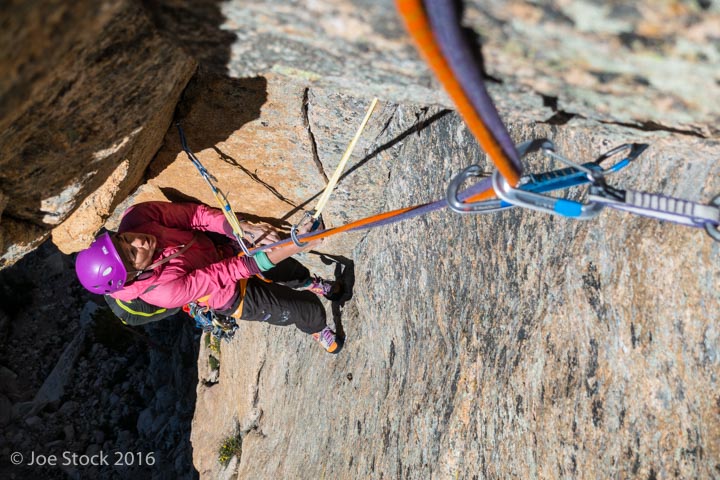
Rude awakening on day two. We found this first 5.10b layback pitch on Astro Elephant to be a stout, old-school pump-fest. Pitch seven had the notorious grade of old-school 5.9+ with runout face holds on a prow above 1,000 feet of air. Wow!
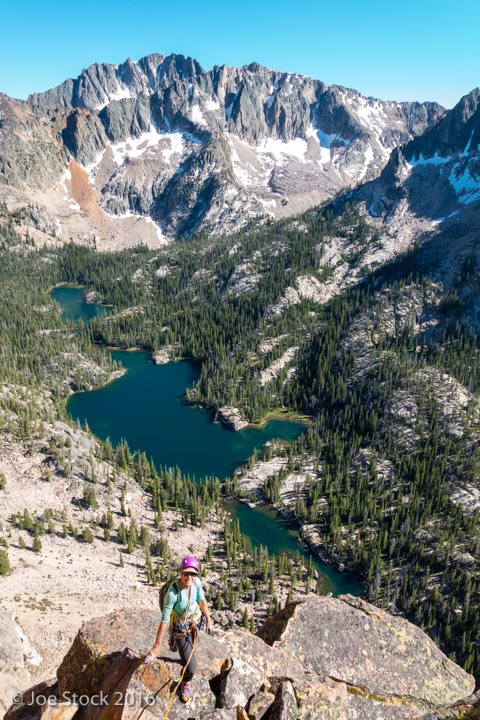
Cathy on the ninth and penultimate pitch of Astro Elephant. Our camp is on the granite isthmus between the lakes below.
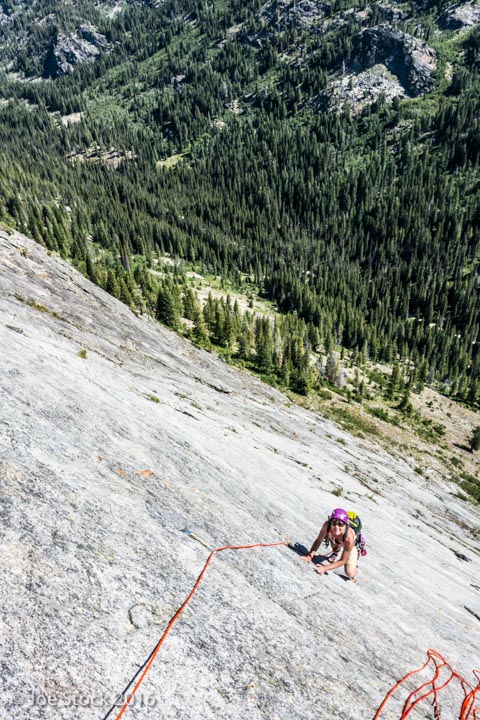
Cathy on Slick Rock near McCall Idaho. This 1,300-foot 5.fun route was 20 minutes from the Flanagan family reunion lodge in McCall. This year was Cathy's turn to organize the family reunion. I helped her select a strategic location.

Tico Allule rappelling the Pyramid du Tacul above the Mer de Glac near Chamonix. Tico wanted to "romp up something" to shake off his jet lag. This classic 300-meter route was a romp, and somehow we didn't get the rappel ropes stuck on the way down.
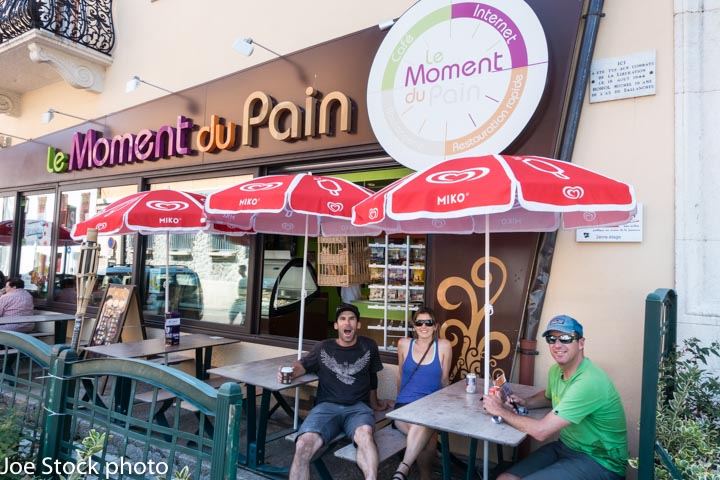
Andrew, Margo and Eric soothing the pain after sports climbing near Chamonix. FYI, in the US they sport climb, in Euro they sports climb.

Rachel Spitzer acclimatizing on overhanging 5.10 at 12,000 feet on the Éperon des Cosmiques.

Cathy and I on the Rébuffat route on the Minaret near the Argentierre Hut. 300 meters of red granite just 30 minutes from one of the best huts near Chamonix.
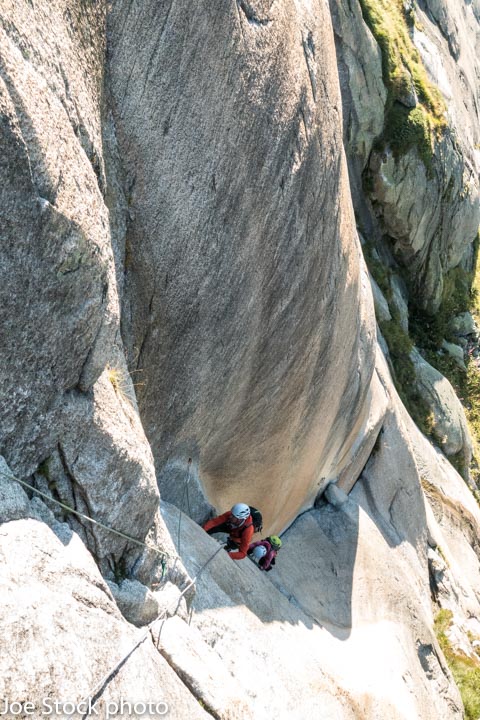
Eric Larson and Cathy climbing pitch five of 15 on Motorhead at Grimsel Pass in Switzerland. The night before we drove from Chamonix to Balhmer's Tent Village in Interlakken, drank beers, slept, woke at ass-crack thirty, drove, climbed and were back in Chamonix that evening.
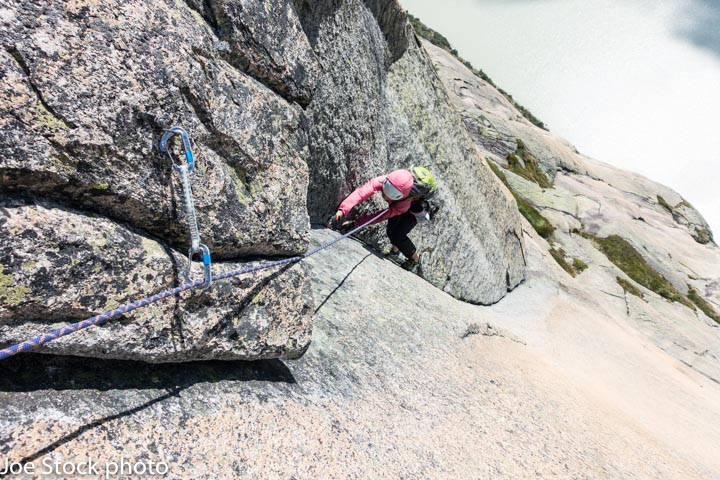
Cathy following Eric's lead of what felt to me like the crux of Motorhead: 6b fingertips and smearing on glacier polish. The crack is bolted just in case you forgot which continent your are on. The actual crux came on pitch eight, which Cathy led.
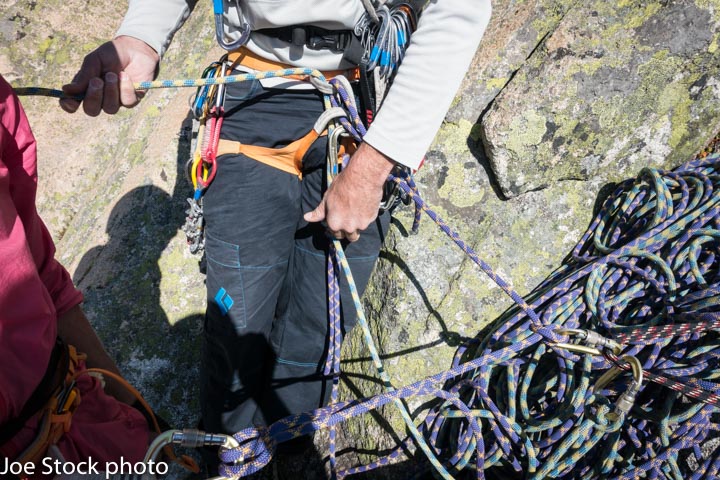
Cathy and Eric using the backside clove to change lead blocks. When climbing as a team of three, it's best to climb in blocks to minimize rope snafu's. This use of the backside clove is one of several tips that Eric reminded me of on the route:
Backside Clove: When transitioning from climbing to rappelling, or when transitioning block leaders as a team of three, use the backside clove to free up the ends.
Air Clove: As a second, when clove hitching into the anchor between your knot and a belay device in plaquette mode, build the clove in the air, not on the locker. If you build the clove directly on the locker, it could prevent the plaquette from catching.
Clove Belay: When belaying using a plaquette, you can air clove your second into a locker as they approach the belay. Belay them in the final bit by adjusting the clove.
Tangle Free: When guiding two clients on two ropes, assure the ropes are tangle-free before you start leading. If clients encounter tangles when you are 150 feet away, they may untie to solve the problem. You don't want clients to untie!

Cathy, Danny Uhlmann and Odin the Ancient Doggie at our place in Chamonix. Earlier I was sharing an apartment with Andrew in a more typical Chamonix condo with Ikea walls and a moldy carpet. The problem with this situation is that it's easy to move up in the world. It's not so easy to move back to moldy carpets.
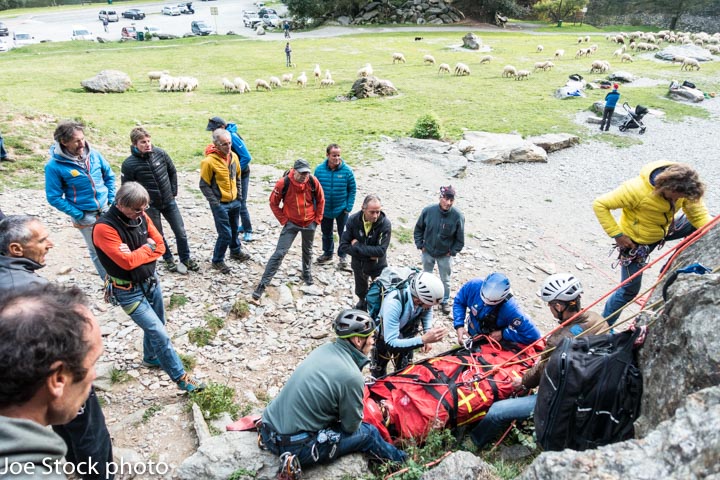
Much of my mental energy this summer was focussed on surviving the recyclage in Chamonix. The recyclage is a three-day continuing ed class for French mountain guides. French guides must take the recyclage every six years. Americans working in France also need to take it. I love learning about guide stuff. The problem was this course was entirely in French, and my French is not the best. Plus, French guides would like to work on Denali and that's not allowed. So I was good and nervous going in, especially without another American as wingman.
As it turns out, the two instructors and 15 salty-dog French guides were super friendly. They translated a bunch for me and were all so kind. The French, what beautiful people.
The recyclage focus was communication. We did a day of first aid and rescue, but that still focussed on communication. They've found that when there are more French guides working near each other the number of accidents goes up. Why? Maybe because of competitiveness, shyness, or worrying what other guides are thinking. As you may have seen in the huts; the closest thing to a guide meeting is the guide apéritif. I'd say American guides do a great job at communication. Perhaps second only to Canadian guides.
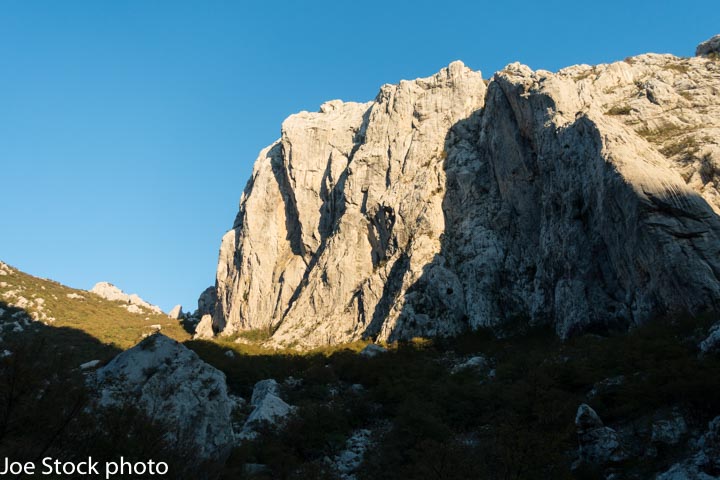
The Anika Kuk in Paklenica, Croatia. Cathy and I spent two weeks here working, living by the ocean, climbing 300-meter routes, watching sunsets and drinking Czech beer.
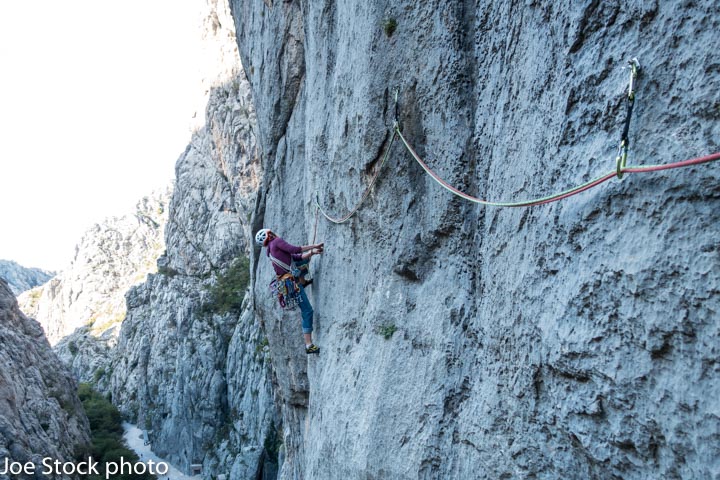
Cathy floating through the 6b+ crux of Senza Pieta. Thin holds that make you say "ouch!" The approach is five minutes up the road below.
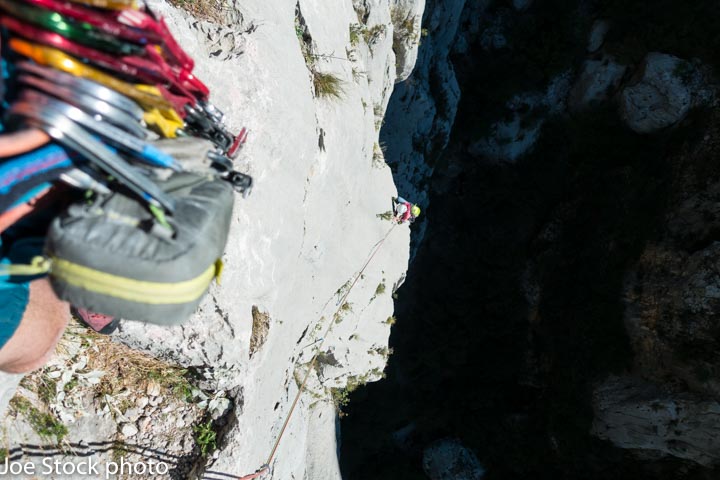
Higher on Senza Pieta. The last pitch was overhanging jugs far above the trail.
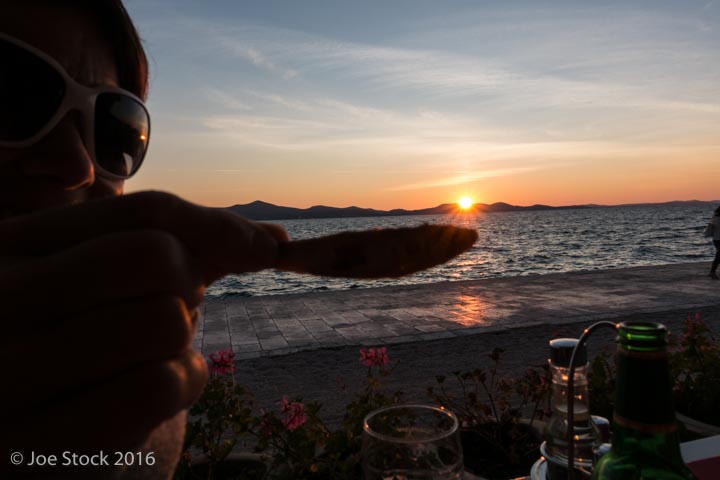
One evening we drove to Zadar to see the "most beautiful sunset in the world." We used a small fried fish to measure exactly how beautiful the sunset was.
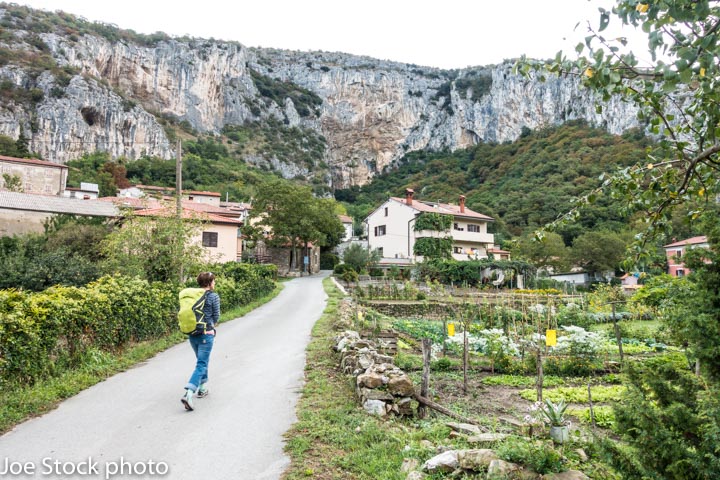
Cathy walking through Osp, Slovenia, not far from Trieste, Italy. We climbed two days in this massive limestone sinkhole lined with sport climbs.
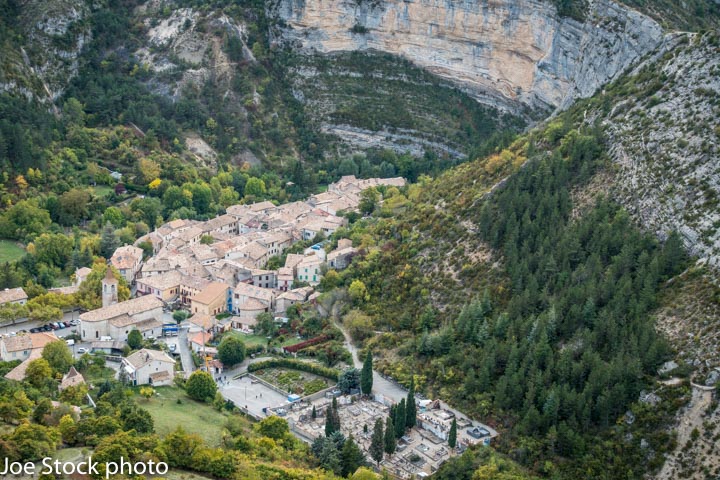
We finished our Euro trip with four days in Orpierre, a medieval village in Haute Provence surrounded by sunny limestone cliffs. Most of our summer climbing had been on long routes with airy cruxes—not the best place to push your grades. We wanted to clip bolts near the ground.
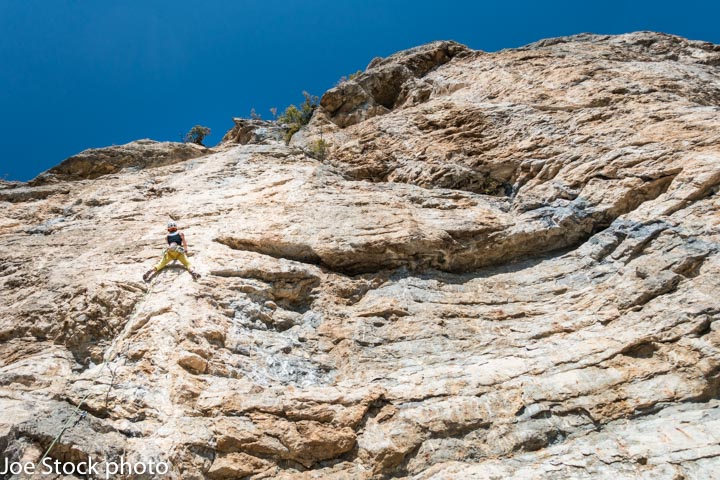
A happy wiffy clipping bolts and pulling on pumpy overhanging holds at Orpierre.

The Chamonix stash is still growing, but so is my passion for home in Southcentral Alaska! See you next summer Euroland!
Managing Client Expectations
Happy clients make happy guides
Near the summit of Mont Blanc, our clients huddled together and discussed the route ahead. The night before, at the Tête Rousse hut, co-guide Matthieu Desprat spent an hour telling them about the route. They knew the next section to the summit was steeper, exposed to higher wind and lower oxygen. They also knew that the summit was only halfway to safety. They were tired and the wind had increased. Among themselves, they decided to turn around and try again another day. This was an ideal situation; the guide presented the necessary information in advance and the clients felt the decision was their own.

Discussing the route at the Refuge de Tête Rousse, Mount Blanc, France.
* * *
Mountain guides say their job has three parts: to minimize risk, to achieve the client's objective and to show the client a good time. Within these jobs, one of the more difficult is to manage the client’s expectations about an objective. Descending from an unreached summit with a disgruntled client is a bad situation for any guide. So what makes the difference between clients who agree to turn back and those who blame the guide for their failure?
Managing client expectations takes maturity and practice. It's a skill that some career guides have mastered and newer guides should be aware of and work toward. The following are some techniques for managing client expectations. Some of the concepts are borrowed from business. Others are unique to guiding.
1) Discuss objectives and risks.
First of all, try to understand your clients’ objectives—just as competent doctors listen to their patients before prescribing treatment. Before the trip, ask them what they want to get out of the trip. Say, for example, "What is your goal for this trip?" or "Do you want to spend time on skills or focus on an objective?" With a better understanding of your client’s desires you can present options that better match their desires. Explain the pros and cons of each and incorporate their ideas into the decision. If their expectations are unreasonable, give them enough information about the objective so they can see that another objective is better.
Also, before the trip, discuss risk with the client. Review the dangers that will be encountered. Explain that you cannot make the trip safe, but your priority will be to minimize the risks. Explain that returning alive and in one piece is paramount and that any final decision is yours.
Problems arise when a client does not respect or accept the guide's decision. Help alleviate the problem by pointing out and explaining the hazards and reiterating the trip priorities as you go along.
Clients may also have a different risk tolerance than the guide. For example, if the guide feels uncertain about the snow stability and turns the group around, but a client wants to keep going, the client either has not been well informed about risks or the client has a greater risk tolerance than the guide. In this the latter case, the guide-client relationship is not compatible. On future trips, the client may be better suited to another guide with a higher risk tolerance.
2) Frontload communication.
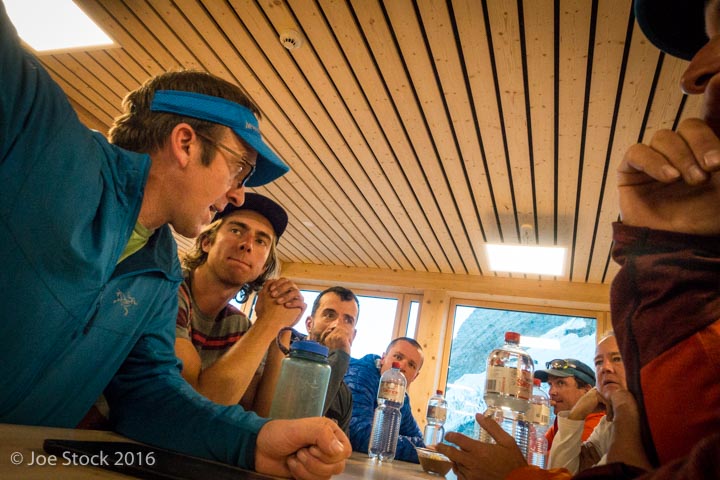
Dylan Taylor briefing clients at the Hornli Hut the evening before climbing the Matterhorn, Switzerland.
Before the trip, keep the clients informed through a pre-trip letter. When possible, be available on email or by phone. This communication helps replace trip anxiety with trip anticipation.
At the pre-trip meeting, look at the weather forecast, avalanche advisory and maps together. This gives the client a clear mental picture of the route and conditions.
Continue to frontload communication throughout the trip. Provide information before each day and at each transition, just as you make a plan before crossing avalanche terrain. Armed with more information, the client will have a more accurate perception of the risk and will be easier to work with.
3) Underpromise, overdeliver.
Newer clients often want concrete answers, such as being told they will get to the summit. They can have a difficult time understanding the uncertainties encountered in the mountains. If clients have high expectations and those expectations are not met, they will be disappointed. If clients have lower expectations and are surprised with a success, they will have a better experience.
To reduce their expectations, make promises you can keep. Like, "I will make my best effort to get you to the summit, but the summit is not guaranteed." Forewarn them that the summit is one of the possible outcomes. Use phrases like, “Remember that the summit is only halfway.” Remain non-committal by using terminology like, "Let's go up to 9,000 feet and look at our options." Keep an attitude that concentrates on the journey, not the destination, so the summit is not the singular goal.
4) Make decisions with clients.
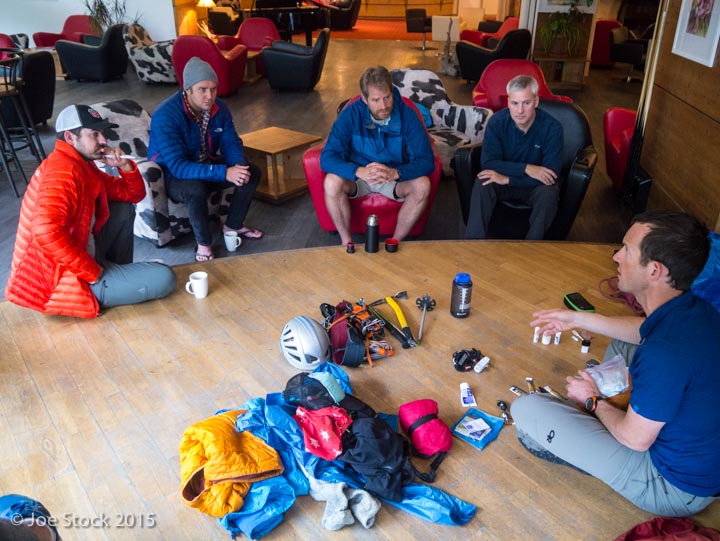
Forest McBrian discussing the gear in his pack before a trip.
A guide's job is managing risk with good decision-making; the guide has the final call with all safety decisions. While this is a powerful position, the experienced guide includes clients in many decisions.
From the start of the trip, include clients in decision-making. The earlier the better. This serves to enhance their appreciation for the challenges and lessen their disappointment if an objective cannot be achieved.
Select the route with your clients. Seriously consider any suggestions they make; they are often good. As IFMGA Mountain Guide Willie Benegas wrote, "Clients are your climbing partners, decision making should be done as a team." This invests them in the trip and they are better prepared to switch to plan B or C if needed.
The ultimate goal is to have clients make key decisions themselves. If the guide provides the clients with the right information and uses gentle nudges (indirect suggestions), the clients can feel the decision is theirs. This empowers the clients and leads to a better group dynamic.
The wisdom of groups was illustrated by Lior Zoref, who brought an ox onto the TED stage. Each person in the audience submitted their guess of the ox's weight. The low guess was 308 pounds. The high guess was over 8000. The average was 1792. The ox's true weight was 1795.
5) Help clients cope with failure.
What if you fail to reach an objective that your client really wants? If the client is adequately prepped, it won’t be a shock. IFMGA Mountain Guide Kathy Cosley says that if a client's failure is due to their own limitations (such as lack of fitness or skill), use tact and come up with suggestions and a training schedule for the next attempt. If mountain conditions (external factors) are the reason for the failure, then the situation is more straightforward. Reassure them that the mountain will always be there, but it can't always be climbed on their terms. Tell them that's why it's called mountaineering, not summiting. Despite your best efforts, sometimes a client will be upset and time may be the best remedy.
* * *
It's easy to keep a client happy when things are going well. Your guiding skills are truly tested when the plan goes awry. It takes diligence to hone your skills at managing client expectations, but it's worth it. It will lead you to the grail of mountain guiding: return clients and lasting friendships.
A checklist for managing client expectations through communication
Prior to and during the trip
Pre-trip letter to client?
Ideal objective and alternates identified?
Route and maps viewed with client?
Weather reviewed with client?
Risks reviewed with client?
Client knows that minimizing risk is your priority and the final decision is yours?
Client encouraged to focus on the journey, not just the destination?
Ski guiding
Avalanche advisory viewed with client?
Terrain progression explained?
Companion rescue reviewed with client?
Tour plan reviewed with client?
More Reading
AMGA Professional Members Forum, Facebook.com (accessed July 3, 2015).
Mountain Craft. Arc'teryx. (August 29, 2015).
The Top Five Tips for Managing Client Expectations, by Annie Pace Scranton, Forbes.com, (accessed July 3, 2015).
The Wisdom of Crowds, by Lior Zoref, TED, (accessed July 3, 2015).
